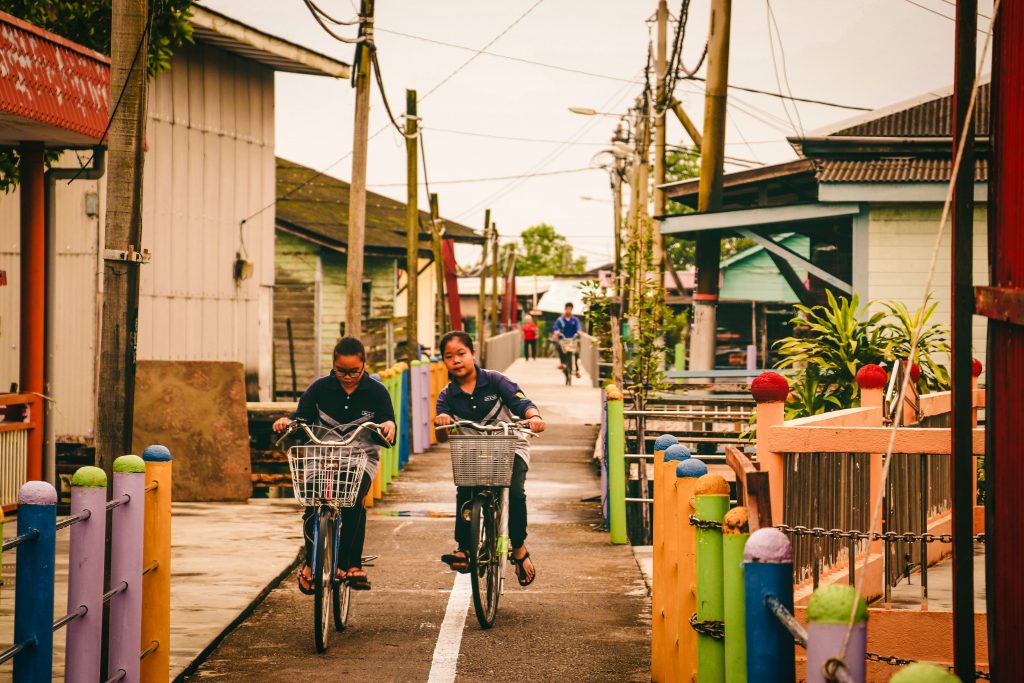Trying to encourage children to cycle to school? Follow these tried and tested ideas, and you’ll be sure to pass with flying colours!
Why Cycling Comes Top of the Class
Although convenient, driving to school by car has its downsides. If there are too many cars, congestion halts the start of the day. Pollutants cling to the playground and clog up the air quality that children breathe. Limited physical exercise leads to child obesity: 1 in 5 are overweight worldwide.
Cycling to class can improve that. Active travel increases fitness, reduces car pollutants, eases congestion and gives children greater confidence and independence. Since journeys to school are the same each day and typically less than 5km, cycling is a reliable and accessible option. You’ll be impressed to learn that cycling also increases concentration levels – so pedalling can make you smarter.
Ready, Steady… Go?
Despite the benefits of cycling, some major obstacles stop children from getting past the starting line. ‘Ready, steady, go!’ is often easier said than done.
“Safety is a big concern for teachers and parents, as well as cycle parking facilities,” says Rebecca Langdell, spokesperson for London’s STARS scheme which promotes sustainable travel to school. “Another barrier for parents is time,” she notes, and that “not all children have access to a bike at home.” Needless to say, wet weather can equally dampen cycling plans.
Obstacles faced by pupils also differ depending on their age. “The key task with primary school pupils is to encourage children to gain confidence in riding a bike or scooting,” says Rebecca, “in contrast, secondary school children are more likely to cycle independently.” For teenagers, peer pressure and image often play a greater role in whether to bike to school.

Tackling these barriers is necessary if pupils are to feel comfortable in cycling to school. No set answers nor textbook examples exist on how to do this: each school will have different needs. However, it isn’t a class test – copying ideas from other cities is a great place to start.
Learning by Heart: Ways to Get Started
Below, we’ve summarised the best tried and tested ways schools have encouraged children to cycle. It’s a ‘Pick n’ Mix’ of options, so each school can choose the ones it likes best. Ranging from event ideas to safety measures, to extra-circular activities, there is a great selection to sample from.
Safety Measures
“It’s really important that safe cycle routes are available for children,” says Rebecca. Since fear of traffic is one of the biggest obstacles to cycling, safety concerns need to be addressed. Here are some key actions to make cycling to school a safe and fun, rather than perilous, journey:
- Exclusion zones – restrict roads in front of schools from being used by motorised traffic during the school drop-off and pick-up times, as trailed in London
- Pressure local governments – write letters and sign petitions asking local governments for traffic calming measures or cycle tracks on major school routes; even invite councillors on the school run so they can experience it for themselves
- Cycling Lessons – already compulsory in many schools in Europe, teach children how to ride a bike and road safety. The Bikeability course provides a good curriculum example
- Bike Maintenance classes – invite a bicycle mechanic, so-called ‘Dr Bike’, to schools to teach children (and guardians) basic maintenance and check their bicycles
- Bike facilities – schools should provide secure bike parking facilities, lockers for helmets and bicycle pumps
- Posters – place posters telling drivers to slow down and pay attention around school
Bicycle Events
Hosting large events that involve teachers, students and guardians increases the hype and profile of cycling. Here are some ideas from other cities:
- A Bike to School Week – in the UK, Sustrans lead a yearly national week dedicated to bicycle-related activities at school
- Cycling parade – organise a large family-friendly cycle ride through the streets; Milan’s Cyclopride was led by school students in 2015
- Fancy Dress Ride– a school in Krakow held an ‘Escape on two wheels’ where teachers, guardians and pupils cycled with costumes on
- A Car-Free Day – all staff, pupils and guardians have to use sustainable transport for the day
- Local Cycle Tour – Hackney in London’s annual ‘Bike around the Borough’ broke the world record for the longest bike bus for children
Incentives
Very few children will not respond to some positive reinforcement for their cycling efforts. Here are some popular tricks tried in other schools:
- Bikers breakfast – one of London’s STARS most successful schemes is giving out breakfast vouchers to children who cycle
- Bicycle Banner – in Brussels, children who cycled or walked to school could add a sticker to a large snake banner outside the school
- Reward Points – aside from breakfasts, prizes like extra playing time, gadgets or no homework for a day can be gained for cycling
- Cycling Apps – ‘Bicycle Friend’ is an app used in Odense, Denmark which mimics the Pokémon go app to encourage cycling
- Classmate competitions – pupils can log their cycling trips to compete for prizes
- School Accreditation – as part of the European STARS project, schools can receive a bronze, silver or gold award based on their commitments to cycling

Extra-Circular Activities:
There are lots of things schools can do to cultivate a cycling culture. “Teachers are a great influence on young people,” says Rebecca. “To see teachers cycling or walking to school is a key element in encouraging the pupils to follow.” Here are some ways teachers and schools can embed a cycling mindset:
- Teacher Ambassadors – have a group of dedicated teachers who are the designated cycling advocates and can create a cycling culture at the school
- Student Champions – pupils can group together to campaign for cycling changes and liaise with the teacher ambassadors
- Bike clubs – some schools hold after school bike polo or BMX clubs to promote cycling recreationally
- Bling your bike – this activity is popular with London’s STARS programme, where pupils decorate their bike at school
- Exchange trips – inspire children by exposing them to schools with cycling cultures, as seen in the European STARS exchange trip where children in Bielefeld, Germany visited students in Edinburgh, Scotland to compare cycling routes
Get Parents Onboard
“Getting the parents on board is always beneficial,” says Rebecca, “especially in primary aged children who have less independence when it comes to their journey to school.” To do this, cycling needs to be a feasible option for guardians. Here are some ways to lure them in:
- Park and ride – part of the STARS scheme provides drop off areas for guardians in cars, allowing children to walk (stride) or ride the rest of the way accompanied by a school warden
- Bike bus – from a pre-arranged meeting point, children can cycle together accompanied by a rota of guardians. This great guide from two Scottish primary schools outlines how to set up a bike bus
- Local Maps – provide a map of the safest and easiest cycle routes to school
- School letters – raise awareness of the pollution costs and benefits of cycling through letters sent home from school
- Pool Bikes – launch a bike borrowing scheme for those without bicycles, based on donations from the community, guardians and bike shops. See an example from Calgary, where the campaign group Bike Calgary paired with local bike companies and schools
In a Nutshell…
It doesn’t take a teacher’s pet to know that cycling to school is a bright idea. Not only does it bring health and environmental benefits, children who start cycling young are likely to carry that legacy into the future. So, go on and dip into this Pick n’ Mix of ideas to end the car-clogged starts to the school day.


